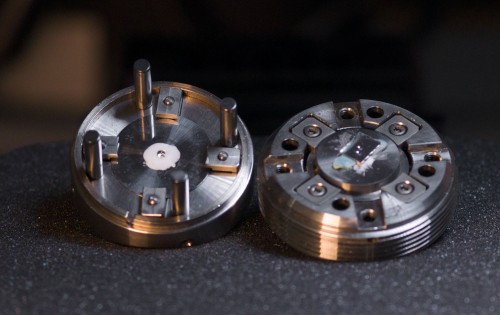Tag archives: X-ray
In flight around the world’s brightest laser and the inverse Cheerio effect
By Tushna Commissariat
If you have never been one of the lucky few to have wandered the tunnels of a particle accelerator, but have always wondered what lies within, take a look at the video above. The European X-ray Free Electron Laser (European XFEL) – which is currently under construction in Germany and will come online next year – will provide ultrashort (27,000 X-ray flashes per second) and ultrabright X-ray laser flashes that are needed to study chemical reactions in situ or to study extreme states of matter (you can read more about the kind of research that will be done there in the September issue of Physics World magazine). The XFEL tunnel is 3.4 km long and you can zoom across all of it in the 5 minute long video. I particularly enjoyed watching particular locations where engineers could be seen carrying out tests, as well as watching folks on bicycles wobble out of the camera’s way.
On a slightly related note, if, like me, you occasionally get a bit muddled when it comes to certain details of different particle accelerators – for example which came first, the synchrotron or the cyclotron – take a look at this excellent “primer” over at Symmetry magazine.
View all posts by this author | View this author's profile
Scientists recreate pressures and temperatures found deep within the Earth

An opened diamond anvil cell. The diamond is visible at the centre of the left disc.
(Courtesy: ESRF/Blascha Faust)
By Ian Randall in New Zealand
We owe our existence to the liquid nature of the Earth’s outer core. Without its internal convection our planet would have no magnetic field to shield us and solar winds would rip away most of our atmosphere. Indeed, this is probably what happened to our neighbour Mars. Despite its importance, however, we don’t know that much about conditions within the core. This is why a recent high-pressure experiment is so important.
View all posts by this author | View this author's profile
Mysterious ‘superflares’ confound astronomers
By Tushna Commissariat
Most of us with an interest in astronomy would recognize the Crab Nebula in images and videos quite readily. The supernova remnant, first seen on Earth in the year 1054, consists of a super-dense neutron start that spins about 30 times an second, making it a pulsar that swings a beam of radiation towards Earth, like a lighthouse.
NASA’s Fermi Gamma-ray Space Telescope is one of many that look for high-energy radiation sources, and recently the Crab Nebula has caught its eye. The past seven months have seen some rather dramatic variations within the nebula, with Fermi and other telescopes noticing X-ray flares a hundred times brighter than seen ever before.
Since 2009 Fermi has detected several short-lived gamma-ray flares at energies greater than 100 million electron volts (eV), which is much higher than the flares seen before. On 12 April Fermi detected a flare that grew about 30 times more energetic than the nebula’s normal gamma-ray output and about five times more powerful than previous outbursts. On 16 April an even brighter flare erupted, which lasted for a few days before the activity died out.
“These superflares are the most intense outbursts we’ve seen to date and they are all extremely puzzling events,” says Alice Harding of NASA’s Goddard Space Flight Center. “We think they are caused by sudden rearrangements of the magnetic field not far from the neutron star, but exactly where that’s happening remains a mystery.”
When Fermi noted the variances in 2010 it alerted NASA’s Chandra X-ray Observatory, which began routinely monitoring the nebula to identify X-ray emissions associated with the outbursts. When Fermi scientists alerted the astronomers at Chandra about the spike in April, a pre-planned set of observations using the observatory was initiated.
Unfortunately, no clear evidence was seen for correlated flares in the Chandra images, so the reason for the sudden extreme variations is still a mystery. Theorists have deduced that the flares must arise within about one-third of a light-year from the neutron star, but efforts to locate them more precisely have been unsuccessful.
Scientists believe the flares occur as the intense magnetic field near the pulsar undergoes sudden structural changes. Such changes can accelerate electrons to velocities near the speed of light. As these relativistic electrons interact with the magnetic field, they emit gamma rays. To account for the observed emission, scientists say the electrons must have energies 100 times greater than can be achieved in any particle accelerator on Earth. This makes them the highest energy electrons associated with any source within our galaxy.
Take a look at the wonderful video by NASA that shows the changes as seen by Chandra, as well as some spectacular shots of the nebula.
View all posts by this author | View this author's profile